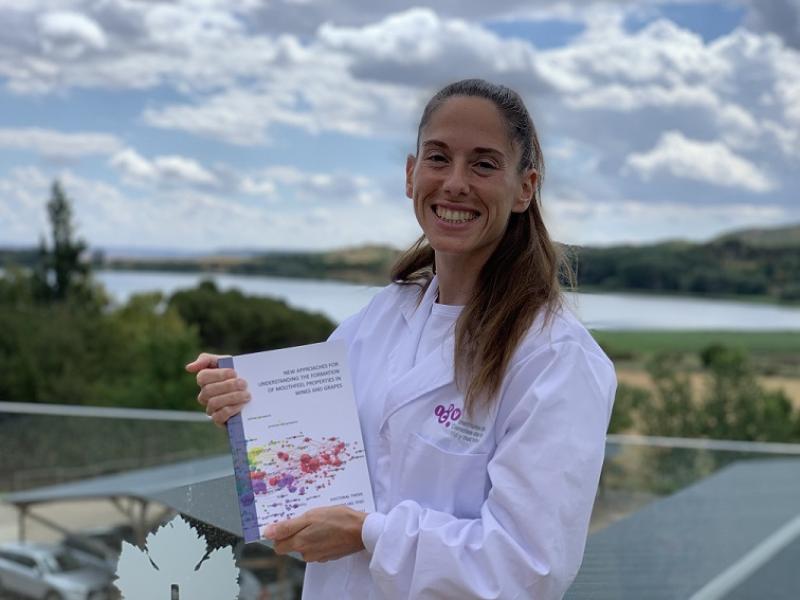Sara Ferrero del Teso has completed a Ph. D undertaking research at the Instituto de Ciencias de la Vid y del Vino (CSIC-GR-UR). She has studied the compounds and/or chemical factors responsible for wine mouthfeel perception, such as general astringency, dryness or stickiness. This research has also required working on the sensory vocabulary of these sensations with a panel of experts, which has made it possible to propose a sensory vocabulary, made up of 18 terms, to name these perceptions.
The thesis, entitled New approaches for understanding the formation of mouthfeel properties in wines and grapes, has been carried out within the Doctoral Program of Oenology, Viticulture and Sustainability at the Universidad de La Rioja (UR), supervised by Dr. Purificación Fernández Zurbano (UR) and Dr. María Pilar Sáenz Navajas (CSIC), researchers at the Instituto de Ciencias de la Vid y del Vino (CSIC-GR-UR). Sara Ferrero has been awarded with the highest qualification with honours.
Among the senses involved in flavour (olfaction, taste, mouthfeel), the formation of mouthfeel is overall the least understood, which is especially important in the case of complex systems such as wine, which makes its study especially relevant for the wine industry. Mouthfeel perception occurs in the oral cavity, where mechanical and chemical processes take place.
During the investigation, sensory and chemical strategies have been combined. "We separated the components of the wine into different parts (fractions), which were evaluated by experts using different sensory methodologies and the chemical compounds found in each one were analysed" -explains Sara Ferrero-. In this way, fractions obtained were chemically simpler and with lower sensory complexity, which allowed the study of mouthfeel perceptions.
To determine mouthfeel attributes, wine is sensory evaluated by a panel of experts: “they taste it and describe their perceptions”. However, it is difficult to obtain a complete sensory profile, since the substances that originate them are still unknown and therefore there are no reference materials that unequivocally illustrate these properties. This research, has been able to isolate groups of non-volatile compounds eliciting different in-mouth properties. This has allowed the development of a wide sensory vocabulary that describes in-mouth relevant sensory properties, made up of 18 terms: burning, dusty, coarse, dry, dry on palate, dry on tongue side, fleshy, grainy, gummy, hot, mouthcoating, oily, prickly, sandy, silky, sticky, unctuous, watery.
Among all the families of polyphenols present in wine, it is conventionally known that anthocyanins (pigments present in the skin of the grape) are responsible for the colour contribution of red wines. However, the results of this doctoral thesis support that those anthocyanins would be involved in the mouthfeel produced by wines. Thus, the fraction of anthocyanins obtained from certain wines was described as dry, bitter and persistent.
Other descriptors have also been studied, such as the term "green character" used by experts to describe a sensation that they were observing recurrently in wines associated with climate change and that was generating a depreciation of their products. As a result, the anthocyanic isolated fraction of wines described with high "green character" was found to be related to in-mouth properties as stickiness, described by experts as dry tannins, while the isolated fraction containing tannins was found to be related to attributes of dryness (coarse, dry, drying on palate and persistent) described by experts as green tannins. Thus, the "green character" resulted to be a multidimensional term associated with descriptors of aroma, taste and mouthfeel sensations, which was effectively negatively correlated with wine preference.
It is noteworthy that novel parameters were studied for tannins, such as tannin activity (Revelette et al., 2014), which consists of measuring the interaction between tannins and a hydrophobic surface, simulating the reaction that would occur with saliva proteins. This chemical parameter could be correlated with the general perception of astringency. Tannin activity has been suggested as a very interesting parameter that can help control grape maturity, especially because it is independent from other polyphenolic chemical variables.
In addition, as a result of the two stays carried out at Center of Ricerca e Innovazione of Fundación Edmund Mach in San Michele Alládige, Trento (Italy), an interesting senso-chemical strategy to characterise the mouthfeel properties, where Untargeted analytical methods combined with sensory analysis have proven to be a useful tool for elucidating the chemical basis of flavour. Remarkable the results obtained in which sulfonated flavonoids play an important role in reducing the perception of astringency, probably due to the alteration of the structure of the tannins, as pointed out by other authors. (Ma, Watrelot, Addison, & Waterhouse, 2018).
This research increase knowledge about mouthfeel properties formation and reveals some of the compounds and parameters that modulate this perception in wines and grapes. This information is of great interest to wine sector, since flavour and other intrinsic properties of the wine, along with extrinsic factors (label design, packaging, etc.), play an important role on quality perception and acceptance of the product by the consumer.
For the development of her thesis, Sara Ferrero del Teso was awarded with a FPI fellowship funded by the Government of La Rioja.








